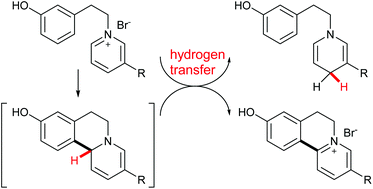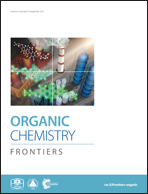Transition-metal-free dehydrogenation coupling of pyridinium through a self-promoted hydride transfer process†
Abstract
A transition-metal-free intramolecular cross dehydrogenation coupling reaction of pyridinium was developed. The C(sp2)–H/C(sp2)–H coupling reaction involved an unprecedented intermolecular hydride transfer process from the 1,2-dihydropyridine intermediate to another molecule of pyridinium and formed 1,4-dihydropyridine. Unlike the well-known dehydrogenation coupling proceeded under oxidative conditions, this was the first example of the coupling reaction through a substrate self-promoted hydride transfer process.

- This article is part of the themed collection: Organic Chemistry Frontiers HOT articles for 2017

 Please wait while we load your content...
Please wait while we load your content...